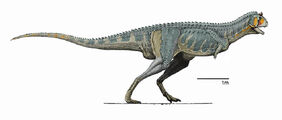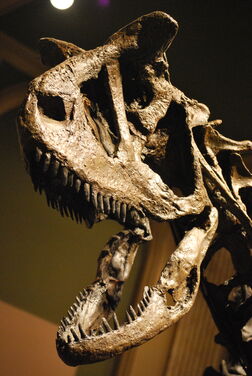

Carnotaurus (pronounced /ˌkɑrnɵˈtɔrəs/; meaning "meat-eating bull", referring to its distinct bull-like horns (Latin carne = flesh + Greek tauros = bull) was a large predatory dinosaur, with horns vaguely resembling a bull's. Only one species, Carnotaurus sastrei has been described so far.
Carnotaurus lived in Patagonia, Argentina (La Colonia Formation) during the Maastrichtian stage of the Late Cretaceous, and was discovered by José Bonaparte, who has uncovered many other South American dinosaurs.[1]
Contents[] |
[edit] Description[]
[1][2]Artist's impressionCarnotaurus was a large theropod, about 8 metres (26 ft) in length,[2] with weights varying between 1,488 kg and 2,626 kg (1.6-2.9 short tons), depending on the method of estimation.[3][4] The most distinctive features of Carnotaurus are the two thick horns above the eyes, and the extremely reduced forelimbs with four basic digits,[3] though only the middle two of these ended in finger bones, while the fourth was splint-like and may have represented an external 'spur.' The fingers themselves were fused and immobile, and lacked claws.[5] It is also characterized by its unusually long neck (compared to other abelisaurs), and its small head with box-shaped jaws. The eyes of Carnotaurus faced forward, which is unusual in a dinosaur, and may indicate binocular vision and depth perception.
There is a rather puzzling contrast between Carnotaurus’ deep, robust-looking skull and its shallow, slender lower jaw. So far no-one has worked out what this might imply about its methods of feeding.[6]
A single nearly complete skeleton has been described including impressions of skin along almost the entire right side, that show Carnotaurus lacked feathers, unlike the more advanced coelurosaurian theropods (see also feathered dinosaurs). Instead, the skin is lined with rows of bumps, which become larger toward the spine.
The type species Carnotaurus sastrei is the only known species. Its closest relatives include Aucasaurus (Argentina), Majungasaurus (Madagascar), and Rajasaurus (India). Together, these dinosaurs form the subfamily Carnotaurinae in the family Abelisauridae. Among the carnotaurines, Carnotaurus is most closely related to Aucasaurus, and together these two genera form the tribe Carnotaurini.
[edit] Bite and skull anatomy[]
[3][4]Skull, Kenosha Dinosaur Discovery Museum, Kenosha, WIThe results of three-dimensional finite element analyses performed on Carnotaurus have several implications for the paleobiology of this dinosaur. Among these are: the muscles that closed the jaws were important for reducing stresses on the skull during biting; the bite was weaker but faster than that of Allosaurus; Carnotaurus may have been capable of making hatchet-like attacks with its head; and the skull could not have survived use of the horns for butting.[7]
[edit] In popular culture[]
See also: Cultural depictions of dinosaursSince the mid-1990s, Carnotaurus has been featured occasionally in the popular media. One of its earliest prominent roles in fiction was the 1995 sequel to Jurassic Park, Michael Crichton's The Lost World. In the novel, Carnotaurus was portrayed as having the (completely fictional) ability to change its colour to blend into the background, like a chameleon or a cuttlefish.[8] While it did not appear in the 1997 film adaptation of the novel, Carnotaurus subsequently appeared in numerous tie-ins to the Jurassic Park franchise, including several video games. Another prominent movie role for Carnotaurus came with the 2000 Walt Disney animated film Dinosaur, which featured two Carnotaurus attacking a large herd of herbivorous dinosaurs. The Carnotaurus in the film were much larger than the real life animal, scaled up to proportions more closely resembling the giant theropod Tyrannosaurus. In reality, Carnotaurus was even smaller than Iguanodon, the main dinosaur featured in the Disney picture.[9] A thrill ride at Disney's Animal Kingdom at Walt Disney World also features audio-animatronics of a Carnotaurus.